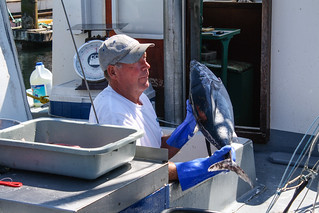July 11, 2016
NEWPORT – What started as an experiment to help bring new customers to fishermen who sold seafood off their vessels has quickly become a favorite summer activity for a growing number of locals and visitors in Newport.
 Sponsored and run by Oregon Sea Grant in partnership with the Port of Newport, “Shop on the Dock” in 2016 is entering its third summer of offering free, guided educational tours of Newport’s commercial fishing docks. Shoppers learn a bit about the fisheries, meet the people who catch the fish, and have an opportunity to buy the freshest salmon, tuna, halibut and crab, usually at prices lower than they’d find at their local supermarkets.
Sponsored and run by Oregon Sea Grant in partnership with the Port of Newport, “Shop on the Dock” in 2016 is entering its third summer of offering free, guided educational tours of Newport’s commercial fishing docks. Shoppers learn a bit about the fisheries, meet the people who catch the fish, and have an opportunity to buy the freshest salmon, tuna, halibut and crab, usually at prices lower than they’d find at their local supermarkets.
The summer of 2016 will see more walks spread over two months – July 15, 22 and 29, and Aug. 5, 12 and 19 – and having multiple walks (at 9:30 a.m., 10 a.m., 10:30 a.m. and 11 a.m.) each date.
“It’s like going down to the docks with a friend who knows the seafood – and knows the fishermen,” said Kaety Jacobson, Sea Grant’s Newport-based Extension fisheries specialist, who runs the program. “We make it easy for people.”
Learn more:
- Read the whole story
- Download a flyer with complete information: dock_shop_2016_color.pdf






